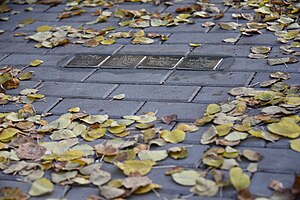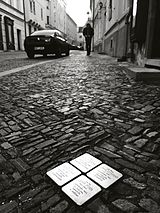List of stumbling blocks in Brno
The list of stumbling blocks in Brno contains the stumbling blocks in Brno (Czech: Brno), the capital of the Czech region Jihomoravský kraj (South Moravian Region), which remind of the fate of the people who were murdered, deported, expelled or in the Czech Republic by the National Socialists committed suicide. The stumbling blocks were laid by Gunter Demnig .
As a rule, stumbling blocks are laid in front of the last self-chosen place of residence. The Czech stumbling block project Stolpersteine.cz was launched in 2008 by the Česká unie židovské mládeže (Czech Union of Jewish Youth). The Stolpersteine are called Kameny zmizelých in Czech , stones of the disappeared.
list
| image | Surname | Location | Life |
|---|---|---|---|
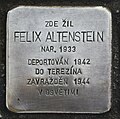
|
Felix Altenstein | Lesnická 11 |
Felix Altenstein was born on November 17, 1933 as the son of Viktor Altenstein and Eliška Altensteinová. He was deported from Brno to Theresienstadt on March 23, 1942 with Transport AD (number 971) , from there he was deported on October 28, 1944 with Transport EV (number 61) to Auschwitz , where he was gassed. |

|
Viktor Altenstein | Lesnická 11 |
Viktor Altenstein was born on November 5, 1899 in Krásno nad Bečvou . From 1920 to 1924 he studied law at the Charles University in Prague. In 1924 he obtained a doctorate in law and from 1927 worked as a lawyer in Brno. On June 28, 1931 he married Eliska, nee Feuerstein; with her he had two children: Anna Altensteinova and Felix Altenstein. During the occupation, he had to give up his legal practice. He and his family were evicted from the house, and on March 23, 1942 the entire family was deported from Brno to Theresienstadt (Viktor Altenstein wore the number 969 during the transport). From here the family was transported to Auschwitz on October 28, 1944 (Viktor Altenstein's number on the transport was 60). The entire family was gassed here. Viktor Altenstein's mother was also a victim of the Shoah; she died in Theresienstadt. Viktor Altenstein is commemorated on a plaque in the Sokol Brno I sports club - he was a member here. |

|
Anna Altensteinová | Lesnická 11 |
Anna Altensteinová was born on July 16, 1938 in Brno as the daughter of Viktor Altenstein and Eliška Altensteinová. She and her entire family were deported from Brno to Theresienstadt on March 23, 1942 with Transport AD (No. 972). From there she was deported (again with her entire family) to Auschwitz on October 28, 1944, where she was gassed. |

|
Eliška Altensteinová (nee Feuereisen) |
Lesnická 11 |
Eliška Altensteinová, (also Alžběta Altensteinová), was born on June 12, 1908 in Brno. On June 28, 1931, she married Viktor Altenstein. The couple had two children, Anna and Felix. On March 23, 1942, she and her whole family were deported from Brno to Theresienstadt on Transport AD (her number was 970). On October 28, 1944, she was transported on the EV transport (her number was 62) to Auschwitz, where she was gassed. |
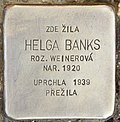
|
Helga Banks (née Weinerová) |
Žampachova 1721/4 |
Helga Banks was born in 1920. Her parents were Armin Weiner and Anna Weinerová. In 1939 she emigrated to London, where she met Kurt Piowaty, who was also from Brno. The couple married and traveled to Panama in 1939. When the United States issued US visas to foreign nationals in the Panama Canal Zone in 1940 , Kurt and Helga went to New York City. The two changed their names to Anthony and Helen Vernon. In 1954 the couple divorced. Helga's father and two siblings (Hansi Hoffmann Weiner and Hetty Levy Weinerová) also emigrated in 1939. The mother Anna Weinerová was murdered in Auschwitz after October 12, 1944. |

|
Leopold Bock | Orli 26 |
Leopold Bock was born in Brno on August 9, 1884. On August 23, 1908, he married Adele, née Parille. The couple had three children. Leopold Bock was a master butcher. On January 31, 1927, he bought a house at 26 Orlí ulici. In 1939/1940 the family was forcibly evicted from the house; the business was also expropriated. Leopold Bock was deported from Brno to Theresienstadt on December 5, 1941 with Transport K (number on the transport: 700); on January 15, 1942, he was deported to Riga on Transport P (number 655). There he was shot near the city on January 19, 1942. His son Erich (born October 26, 1913) survived the war in hiding; he was the only survivor of the family. |

|
Adele Bocková (née Parille) |
Orli 26 |
Adele Bocková was born on November 4, 1885 in Opava. On August 23, 1908, she married Leopold Bock; the couple had 3 children. On December 5, 1941, she was deported to Theresienstadt on Transport K (number on transport: 701). On January 15, 1942, they were deported to Riga on Transport P (number 656). She was shot dead near the city on January 19, 1942. Her son Erich (born October 26, 1913) survived the war in hiding. He was the only survivor in the family. |
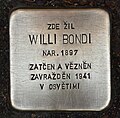
|
Wilhelm Bondi | Captain Jaroše 18 |
Wilhelm Willi Bondi was born on August 9, 1897 in Mariánské Lázne. He was the son of the theater director Gustav Bondi (director of the Brno City Theater ) and the grandson of the educator and writer Emanuel Bondi. Bondi was close friends with Karl Giese , a partner of Magnus Hirschfeld , since he moved to Brno. Bondi spent a lot of time with the family, who had their own box in the Mahen Theater and thus probably enabled Giese to visit the theater for free. Bondi also provided (with the help of another person) the furniture for Giese's apartment in Brno. Bondi Giese also helped translate texts on the homosexual movement. He was of Jewish origin and a member of a homosexual party. He was arrested by the Gestapo during a raid on a party evening. He was deported to Auschwitz, where he was murdered on August 30, 1941. |

|
Moše Moric Breda | Vlhká 176/19 |
Moše Moric Breda was born on April 16, 1923 in Brno. In 1939 he managed to escape - he survived the Holocaust and died on January 19, 2013 in Tel Aviv. He had participated in the war of liberation that led to the establishment of the State of Israel. On August 19, 1951, he married Leah Segal. His parents and his brother Pavel were murdered in Auschwitz in 1944. |
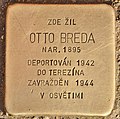
|
Otto Breda | Vlhká 176/19 |
Otto Breda was born on July 1, 1895 in Boskovice. He was married (June 2, 1922) to Olga Bredová (nee Kahn). The couple had two sons, Pavel Breda and Moše Moric Breda. On January 28, 1942, he was deported to Theresienstadt on transport No. U-834; On September 29, 1944, he was transported on with Transport No. El-1499 to Auschwitz, where he was murdered. His wife and son Pavel were also murdered in Auschwitz; only Moše Moric was able to save himself by fleeing. |

|
Pavel Breda | Vlhká 176/19 |
Pavel Breda was born in Brno on May 23, 1924. His parents were Otto and Olga (née Kahn) Breda. Pavel Breda was deported from Brno to Theresienstadt on January 28, 1942 with Transport U (number 836). Here he worked in the youth welfare department. He was deported from here to Auschwitz on September 29, 1944 (Transport EL, number 72). In Auschwitz he died of malnutrition. In the propaganda film The Führer Gives the Jews a City , Pavel Breda can be seen as one of the football players (League of Youth Welfare); the sequence was filmed on September 1, 1944. |
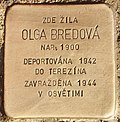
|
Olga Bredová (née Kahn) |
Vlhká 176/19 |
Olga Bredová was born in Turnov on February 14, 1900. On June 2, 1922, she married Otto Breda. The couple had two sons (Pavel and Mose Moric). On January 28, 1942, she was deported from Brno to Theresienstadt on Transport U (No. 835). On October 4th, 1944, she was deported from Theresienstadt to Auschwitz on Transport En (No. 364), where she was gassed. |

|
Berthe Deutsch (née Strakoschová) |
Mášova 24 |
Berthe Deutsch (also Bertha Deutschová) was born on August 15, 1889 in Brno. In 1913 she married Otto Deutsch. The couple had two children - Harald and Gerde Edith Inge Deutsch. On March 23, 1942, she was deported to Theresienstadt on Transport Ad (number 102). On April 25, 1942, she was transported to Warsaw (Transport AN, number 740), where she was killed. Her husband and son did not survive the Shoah either. Only daughter Gerde Edith Inge survived. |

|
Herald German | Mášova 24 |
Herald Deutsch (according to Yad Vashem Harald Deutsch), was born on June 14, 1917 in Brno as the son of Berthe and Otto Deutsch. He was deported from Prague to Theresienstadt on February 25, 1944 (Transport DV, number 17); From there, on May 18, 1944, it was transported on with Transport Eb (number 357) to Auschwitz. Harald Deutsch were finally transferred to the Schwarzheide satellite camp to help rebuild the concentration camp. Here he was murdered on October 1, 1944. |

|
Otto German | Mášova 24 |
Otto Deutsch was born on August 3, 1867 in Brno. In 1913 he married Berthe Deutsch; with her he had two children - Harald and Gerde Edith Inge Deutsch. In 1918 he worked with his brother Moriz in the company of his uncle Heinrich Karl Deutsch as a dealer, and they founded the Brothers Deutsch company , which produced alcoholic beverages, fruit juices and vinegar. A wine shop was added from 1931. When Heinrich Karl Deutsch died in 1931, Otto and Moriz took over their uncle's company. After the occupation of Czechoslovakia, the company was placed under administrative administration and on September 7, 1941, it was forcibly sold to Jemelik Ludwig for 535,000 crowns. After the end of the Second World War, Alois Deutsch became the company's manager. Moriz's son Gerhard Karl Deutsch tries to get the property back and to keep half of the company and its assets; the other half was to go to the surviving daughter of Otto Deutsch, Gerde. But in 1948 the company was nationalized. The new administrator was Rájecké závody lihovarské; there was no redress.
Otto Deutsch was deported to Theresienstadt on March 23, 1942 with Transport AD (No. 101). On April 25, 1942, he was deported to Warsaw on Transport An (No. 739), where he was killed. His wife Berthe also died in Warsaw. His son Harald was murdered in the Schwarzheide concentration camp; only daughter Gerde Edith Inge could survive. |

|
Vladimír Groh | Grohova 56a |
Vladimír Groh was born on January 26, 1895 in Holešov . He was a classical philologist and from 1931 professor of ancient history at Masaryk University in Brno . From 1934 to 1939 he also taught at the Comenius University in Bratislava. On July 10, 1920 he married Marií Roubalovou; with her he had a son, Vladimir. After the National Socialists came to power, he joined the resistance. On February 6, 1941, he was arrested for this and sentenced to death on September 30, 1941 before a court martial for disturbing public safety and order and preparing for high treason. The sentence was carried out on the same day. |

|
Pavel Haas | Smetanova 630/28 |
Pavel Haas was born on June 21, 1899 in Brno to Olga and Zikmund Haas. In 1919 he began training at the newly founded Conservatory in Brno; from 1929 to 1922 he studied composition in the master class of Leoš Janáček.
Pavel Haas initially worked in his father's shoe shop, and for a short time as an opera correspondence editor in Brno and Saarbrücken. His brother Hugo Haas got him work in theaters. From the 1930s he composed music for films in which his brother took part; from 1935 he taught music theory as a private teacher. Eventually he became a music teacher at the University of Brno; he also worked as a freelance composer. After Janáček's death in 1929, Haas succeeded him as chairman of the Moravian Composers' Union. On April 2, 1938, Haas' three-act opera Šarlatán (The Charlatan) was premiered with great success in the Altes Theater am Wall in Brno. After the invasion of German troops in 1939, his music was banned because of his Jewish descent; His non-Jewish wife (Soňa Jakobson, married on October 17, 1935) was also forbidden from any gainful activity. In order to protect her and their daughter (Olga, born November 1, 1937) from further persecution, he divorced. On December 2, 1941, Pavel Haas was deported from Brno to Theresienstadt on Transport G (number 731). In the camp, Pavel Haas continued to compose; his study for string orchestra was premiered on June 23, 1944 when the International Committee of the Red Cross (ICRC) visited. Haas can also be seen briefly in the propaganda film The Führer Gives the Jews a City . After these propaganda campaigns were over, the Nazis ordered all artistic activities to cease in October 1944 and deported many artists, including Haas, to the Auschwitz extermination camp on October 16, where he was murdered on one of the following days. His father Zikmund Haas was also murdered in Auschwitz. His brother Hugo escaped in time and survived. |

|
Zikmund Haas | Smetanova 630/28 |
Zikmund Haas was born in Holice on September 30, 1871. He was married to Olga, nee Epstein. The couple had two sons - Pavel and Hugo Haas. Zikmund Haas was a shoemaker and owned two shops in Brno. On March 29, 1942, he was deported from Brno to Theresienstadt on Transport Ae (number 622), where he was murdered on May 13, 1944. His son Pavel Haas was also murdered (in Auschwitz); his son Hugo escaped in time and survived. |

|
Artur Heinrich | Burianovo náměstí 13 | Artur Heinrich was born on July 23, 1885. He was married to Hildegarda Heinrichová; the couple had a daughter - Dorotea. On March 29, 1942, the entire family was deported from Brno to Theresienstadt on Transport Ae (Artur Heinrich's number was 608). On April 27, 1942, the family was deported to Izbica by Transport Aq (Artur Heinrich had the number 786), where they were all killed. |

|
Dorotea Heinrichova | Burianovo náměstí 13 | Dorotea Heinrichová were born on August 13, 1924; her parents were Artur and Hildegarda Heinrich. On March 29, 1942, like her parents, she was deported from Brno to Theresienstadt on Transport Ae (number 610). From there the family was deported on Transport Aq (Dorotea's number on the transport was 788) to Izbica, where the whole family was murdered. The Passer family owned land east of Prague; surviving heirs are still wanted today (as of 2016). |

|
Hildegarda Heinrichova (née Passer) |
Burianovo náměstí 13 | Hildegarda Heinrichová was born on July 17, 1896. She was married to Artur Heinrich; the couple had a daughter - Dorotea. On March 29, 1942, the entire family was deported from Brno to Theresienstadt on Transport Ae (Hildegarda Heinrichová's number on this transport was 609). On April 27, 1942, the family was deported to Izbica by Transport Aq. Artur (Heinrich had the number 787), where they were all killed. |

|
Leopold Herzog | Orlí 480/7 |
Leopold Herzog was born in Bohemia on May 26, 1876 . He was a trader and married to Emma Herzogová, née Teller. On December 2, 1941, he was deported from Brno to the Theresienstadt ghetto on Transport G (his number was 488). She was murdered on March 12, 1943. The couple had at least one child who survived the Holocaust - the report to Yad Vashem was made through a grandson. |

|
Emma Herzogova (née Teller) |
Orlí 480/7 |
Emma Herzogová (also Ema) was born Emma Teller on November 13, 1884 in Hodonin. She was married to Leopold Herzog. On December 2, 1941, she was deported from Brno to the Theresienstadt ghetto on Transport G (her number was 489). She was murdered on July 15, 1944. The couple had at least one child who survived the Holocaust - the report to Yad Vashem came through a grandson. |

|
Hansi Hoffman | Žampachova 1721/4 |
Hansi Hoffmann, actually Hans Weiner, was born in 1916. His parents were Armin Weiner and Anna Weinerová. He, his father and two siblings (Helga Banks, Hetty Levy Weinerová) managed to escape in 1939 - they survived. The mother Anna Weinerová was murdered in Auschwitz after October 12, 1944. |

|
Hans Horner | Vlhká 173/17 |
Hans Horner was born on April 18, 1892 in Miroslav u Moravského Krumlova. He was a butcher and married to Margarte (Grete) Hornerová, née Bock, who was also a butcher. The couple had two children - Haran and Alice (Lycie) Horner. Hans Horner was a butcher. He and his wife were deported to Theresienstadt on April 24, 1942 (transport AM). From there they were deported to Auschwitz on September 6, 1943 with the transport DI (its number was 850); both were murdered there. The daughter Alice (Lycie), who in the meantime had also been deported to Auschwitz, was murdered at the same time. His son Haran survived. |

|
Alice Lyci Hornerová | Vlhká 173/17 |
Alice (Lycie) Hornerová was born on April 12, 1924. Her parents were Hans and Margarete Horner. She was deported from Prague to Theresienstadt on July 16, 1942 with Transport AAr (her number on the transport was 447). From there she and her parents were deported to Auschwitz on September 6, 1943 with the transport DI (her number was 849); all three were killed there, only their brother Haran survived. |
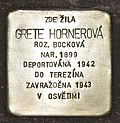
|
Grete Hornerová (nee Bock) |
Vlhká 173/17 |
Margarete (Grete) Hornerová was born on July 30, 1899 in Brno. She was a butcher and married to Hans Horner, also a butcher. The couple had two children - Haran and Alice (Lycie) Horner. She and her husband were deported to Theresienstadt on April 24, 1942 (Transport AM, her number was 411). From there they were deported to Auschwitz on September 6, 1943 with the transport DI; both were murdered there. The daughter Alice (Lycie), who in the meantime had also been deported to Auschwitz, was murdered at the same time. Her son Haran survived. |

|
Jan Jebavý | Heinrichova 215/30 |
Jan Jebavý was born in Brno on October 5, 1908. He studied ophthalmology at Masaryk University and received his doctorate on May 27, 1933. From 1937 to 1941 he taught at Masaryk University. On March 20, 1936 he married Svatava Jebavá (nee Gallusová), a teacher. With her he had a daughter, Hana, who was born on June 17, 1937. On September 1, 1939, he was arrested as part of the Albrecht I campaign and remained in custody in the Špilberk fortress until October 10, 1939. He then joined the resistance and belonged to the organization Obrana národa (Defense of the Nation). He was arrested again on October 8, 1941, and on November 27, 1941, he was indicted in the court martial in Brno and handed over to the Gestapo. On January 20, 1942, he was executed by injection into the heart in Mauthausen concentration camp. |
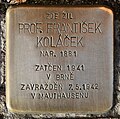
|
František Koláček | Pionýrská 245/7 |
František Koláček was born on December 9, 1881 in Brno. He was the son of the physicist František Koláček and his wife Aloisie Koláčková. From 1921 he taught at the Masaryk University in Brno. First he was a lecturer in regional studies; from 1923 he became associate professor specializing in geography, from 1929 full professor. From 1931 to 1932 he was dean of the Faculty of Natural Sciences and founded the Institute of Geography. He was a member of Česká geografická společnost (ČGS; Czech Geographical Society) and founded a department in Brno in 1924, of which he became the first chairman.
On August 19, 1939, he married the doctor Miroslava Koláčková (nee Kuhnová), who had two children from his first marriage. After the German occupation of Czechoslovakia, Koláček joined the resistance movement of Brno university teachers. He was arrested for this on August 8, 1941 and sentenced to death on January 13, 1942 before the court martial in Brno. The sentence was carried out on May 7, 1942 in Mauthausen concentration camp. |

|
Erwin Laufer | Bratislavská 250/69 |
Erwin Laufer was born on January 29, 1905. He was married to Thea. On April 8, 1942, he was deported from Brno to Theresienstadt on Transport Ai (his number on the transport was 849). On September 29, 1944, he was transported by Transport El (his number on the transport was 92) from Theresienstadt to Auschwitz Birkenau. When the Auschwitz concentration camp was evacuated, he had to go on a death march to Dachau. There he was murdered on March 28, 1945.
The siblings Herta and Karl escaped in time; They were passengers on the Milos , switched to the MS Patria, on which there was an explosion with hundreds of deaths, survived and made it to Eretz Israel . |

|
Franz Laufer | Bratislavská 250/69 |
Franz Laufer (also František Arnošt Laufer) was born on October 27, 1903 in Brno. His parents were Sigfried and Selma Laufer. His mother died after giving birth to his sister Herta; his father married one more time - Helene. By March 1941 at the latest, Franz Laufer was in the Dachau concentration camp ; There is a letter from his father to Adolf Hitler dated March 14, 1941, in which he pleaded for the life of his son. On August 18, 1945, his sister Herta, now Pick, tried to contact him. On January 20, 1947, the Red Cross wrote back to her on this letter, stating that her brother Franz Laufer had been murdered in Dachau on July 1, 1942.
The siblings Herta and Karl managed to flee in time. They were passengers on the Milos , switched to the MS Patria, on which there was an explosion with hundreds of deaths, survived and made it to Eretz Israel . |

|
Helene Laufer | Bratislavská 250/69 |
Helene Laufer was born on February 15, 1881 in Znojmo. She was married to Sigfried Laufer; for this it was the second marriage after the death of his first wife Selma. On April 4, 1942, she was deported from Brno to Theresienstadt on Transport Ah (her number on the transport was 131). From there she was transferred to Rejowiec on April 18, 1942 with Transport Ap (her number on the transport was 398). This transport consisted of 997 people; only three of them survived. Helene Laufer did not survive the Shoah . |
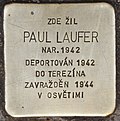
|
Paul Laufer | Bratislavská 250/69 |
Paul Laufer was born on February 19, 1942 in Brno. On April 8, 1942, he was deported from Brno to Theresienstadt on Transport Ai (his number on the transport was 851). On October 6, 1944, he was transferred to Auschwitz on Transport Eo (his number on the transport was 412). Paul Laufer, still a toddler, was murdered in Auschwitz. |
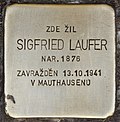
|
Sigfried Laufer | Bratislavská 250/69 |
Sigfried Laufer was born on February 6, 1876 in Vlasatice. His first marriage was to Selma, with whom he had the children Erwin, Franz, Herta and Karl. Selma died after the birth of her daughter Herta. Sigfried was married to Helene Laufer in his second marriage. Son Franz was the first to be deported (1941). In a letter dated April 14, 1941, he pleaded with Adolf Hitler for the life of his son - unsuccessfully. Sigfried was also deported in 1941; he came to Mauthausen, where Sigfried Laufer was murdered on October 13, 1941. His wife Helene was also deported in 1942 and did not survive. Son Erwin was also deported in 1942 and murdered in March 1945.
Only his children Herta and Karl were able to flee in time. They were passengers on the Milos , switched to the MS Patria, on which there was an explosion with hundreds of deaths, survived and made it to Eretz Israel . |

|
Thea Laufer | Bratislavská 250/69 |
Thea Laufer was born on October 16, 1902. She was married to Erwin Laufer. On April 8, 1942, she and her husband were deported from Brno to Theresienstadt on Transport AI (her number on the transport was 850). On October 6, 1944, she was transferred to Auschwitz on Transport Eo (her number on the transport was 411). Thea Laufer did not survive the Shoah . |

|
Hetty Levy (née Weinerová) |
Žampachova 1721/4 |
Hetty Levy was the daughter of Armin Weiner and Anna Weinerová. Her, her father and the two siblings Hansi Hoffmann (Weiner) and Helga Banks managed to escape in 1939 - they survived. The mother Anna Weinerová was murdered in Auschwitz after October 12, 1944. |

|
Adele Löffler (née Berger) |
Táborská 923 / 193a |
Adele Löffler was born on January 17, 1880 in Wallachisch Meseritsch. She was Marta Löwy's sister; Both were deported from Brno to the Theresienstadt ghetto on January 28, 1942 with Transport U (Adele's number on the transport was 807). On April 23, 1942, Adele Löffler was transferred from here on Transport Al to Lublin (her number on the transport was 197). She did not survive the Shoah. |
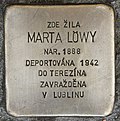
|
Marta Löwy (née Berger) |
Táborská 923 / 193a |
Marta Loewy was born on April 22nd, 1888 in Wallachisch Meseritsch. She was married to Isidor Löwy, a doctor who was born in Uhensky Brod. She lived with him in Luntenburg. Isidor Löwy died before 1939. On January 28, 1942, she and her sister Adele Löffler were deported from Brno to the Theresienstadt ghetto on Transport U (her number on the transport was 759). On April 23, 1942, she was transferred from here on Transport Al to Lublin (her number on the transport was 196). Marta Löwy did not survive the Shoah. |

|
Julius Morgenstern | Purkyňova 2422/86 |
Julius Morgenstern was born on December 16, 1865. He was married to Laura Morgenstern, nee Weinerová. He worked as a machinist. The couple had five children: Richard, Egon, Renate, Armin and Franziska. He was deported from Brno to the Theresienstadt ghetto on March 31, 1942 with Transport Af (his number on the transport was 141). On April 25, 1942, he was transferred to Warsaw on Transport An (his number on the transport was 302). Julius Morgenstern did not survive the Shoah.
Son Richard was married to Božena; the couple had five children: Alžběta (born 1936), Marie (born 1938), Jaroslav (born 1940), Pavel (born 1943) and Petr (born 1942). Richard was deported to Theresienstadt, and finally his children too. All children and Richard survived. In 1947 the family was renamed Malinova . Son Egon also survived; his memoirs appeared as a book (Stanislav Poskočil: Egon Morgenstern - Přežil jsem peklo gulagu). Daughter Renate was murdered in Minsk. Armin had been in the resistance and became an honorary citizen of Lostice. |

|
Laura Morgensternová (nee Weinerová) |
Purkyňova 2422/86 |
Laura Morgensternová was born on July 10, 1880. She was married to Julius Morgenstern and worked as an obstetrician. The couple had five children: Richard, Egon, Renata, Armin and Franziska. She was deported from Brno to the Theresienstadt ghetto on March 31, 1942 with Transport Af (her number on the transport was 142). Laura Morgenrsternová did not survive the Shoah.
Son Richard was married to Božena; the couple had five children: Alžběta (born 1936), Marie (born 1938), Jaroslav (born 1940), Pavel (born 1943) and Petr (born 1942). Richard was deported to Theresienstadt, and finally his children too. All children and Richard survived. In 1947 the family was renamed Malinova . Son Egon also survived; his memoirs appeared as a book (Stanislav Poskočil: Egon Morgenstern - Přežil jsem peklo gulagu). Daughter Renate was murdered in Minsk. Armin had been in the resistance and became an honorary citizen of Lostice. |

|
Renata Morgensternová | Purkyňova 2422/86 |
Renata (Renate) Morgensternová was born on March 9, 1917. She was one of five children of Laura and Julius Morgenstern. On March 31, 1942, she and her parents were deported from Brno to the Theresienstadt ghetto on Transport Af (her number on the transport was 142). On April 18, 1942, she was deported to Minsk on the AP transport (her number on the transport was 261). The train reached Rejowiec on April 20, 1942. Here she was housed in a house whose Jewish residents had previously been murdered to make room again. Renata Morgensternová did not survive the Shoah.
Renata's parents did not survive the Shoah either. Brother Richard was married to Božena, the couple had five children: Alžběta (born 1936), Marie (born 1938), Jaroslav (born 1940), Pavel (born 1943) and Petr (born 1942). Richard was deported to Theresienstadt, and finally his children too. All children and Richard survived. In 1947 the family was renamed Malinova . Brother Egon also survived; his memoirs appeared as a book (Stanislav Poskočil: Egon Morgenstern - Přežil jsem peklo gulagu). Her brother Armin had been in the resistance and became an honorary citizen of Lostice. |

|
Růžena Munková (nee Kohnová) |
Vlhká 15 |
Růžena Munková was born on December 16, 1884. On January 28, 1942 she was deported from Brno to Theresienstadt on Transport U (her number on the transport was 346); from there she was deported to Izbica on March 11, 1942 with Transport Aa (her number on the transport was 687). Růžena Munková did not survive the Shoah . |

|
Richard Musil | Captain Jaroše 8 |
Richard Musil was born on October 22, 1881. He was a lawyer and married to Ida (nee Stukhartová). On January 28, 1942, he and his wife were deported from Brno to Theresienstadt on Transport U (his number on the transport was 124). From there he was transferred to Izbica on March 11, 1942 with Transport Aa, again together with his wife (his number on the transport was 392). Dr. Richard Musil did not survive the Shoah. |

|
Ida Musilová (nee Stukhartová) |
Captain Jaroše 8 |
Ida Musilová was born on March 17, 1889. She was married to the lawyer Richard Musil. On January 28, 1942, she and her husband were deported from Brno to Theresienstadt on Transport U (her number on the transport was 122). From there she was transferred to Izbica on March 11, 1942 with Transport Aa, again together with her husband (her number on the transport was 145). Ida Musilová did not survive the Shoah.
Her brother Hugo Stukhart survived. |
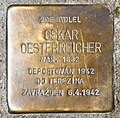
|
Oskar Oesterreicher | Plotní 2 |
Oskar Oesterreicher was born on October 18, 1882 in Arnau. He was a factory owner and married to Marie Irma, née Putzker. On July 4, 1919, the couple became parents of a son - Robert. On March 31, 1942, the entire family was deported from Brno to Theresienstadt on Transport Af (Oskar Österreicher's number on the transport was 221). On April 6, 1942, Oskar Oesterreicher "died" according to his death certificate at 6:50 am from pneumonia.
Marie Irma Oesterreicher was able to survive. Your Robert had joined the resistance in Great Britain; nothing more is known about him. |

|
Marie Irma Oesterreicherová (née Putzker) |
Plotní 2 |
Marie Irma Oesterreicherová was born on February 2, 1896 in Dresden. She was married to the factory owner Oskar Oesterreicher. On July 4, 1919, the couple became parents of a son - Robert. On March 31, 1942, the entire family was deported from Brno to Theresienstadt on Transport Af (Marie Irma Osterreicherová's number on the transport was 222). She survived the war and lived in Czechoslovakia until her death in 1978.
On April 6, 1942, her husband Oskar Oesterreicher "died" of pneumonia, according to the death certificate. Son Robert had joined the resistance in Great Britain; nothing more is known about him. Her parents did not survive Theresienstadt. Her brother Fritz was murdered in Riga in 1942. |

|
Berthold Oppenheim | Bratislavská 246/67 |
Berthold Oppenheim was born on July 6, 1878. His family included Selma Laufer, Sigfried Laufer's first wife - she was his sister. He was a businessman and married to Martha Oppenheimer, née Steiner. The couple had a daughter - Margit, born in 1934. On March 31, 1942, he was deported from Brno to Theresienstadt on Transport Af (his number on the transport was 224). Berthold Oppenheim did not survive the Shoah. |

|
Margit Oppenheim | Bratislavská 246/67 |
Margit Oppenheim was born on May 9, 1934. She was the daughter of Berthold and Martha Oppenheim. On March 31, 1942, she and her parents were deported from Brno to Theresienstadt on Transport Af (her number on the transport was 226). On October 26, 1942, she was transferred from here to Auschwitz (Transport By). Margit Oppenheim did not survive the Shoah. |

|
Martha Oppenheim (née Steiner) |
Bratislavská 246/67 |
Martha Oppenheim was born on December 18, 1896. She was married to Berthold Oppenheim, a businessman. The couple had a daughter - Margit, born in 1934. On March 31, 1942, she and her husband and daughter were deported from Brno to Theresienstadt on Transport Af (her number on the transport was 225). On October 26, 1942, she was transferred to Auschwitz on Transport By (her number on the transport was 413). Martha Oppenheim did not survive the Shoah. |

|
Alice Anna Perlhefter (nee Troller) |
Lidická 1863/16 |
Alice Anna Perlhefter was born on December 23, 1890. She was married to Arthur Perlhefter. The couple had a daughter - Doris Julia, born in 1920, later married Rauch. Arthur Perlhefter died in 1936. On December 5, 1941, Alice Anna Perlhefter was deported from Brno to Theresienstadt on Transport K (her number on the transport was 293). On September 1, 1942, she was transferred to Raasiku on Transport Be (her number on the transport was 76). Alice Anna Perlhefter did not survive the Shoah .
Her daughter Doris Julia Rauch was also deported in 1941 (first to Theresienstadt, then to Estonia in 1942), but was able to survive. |

|
Elsa Piowatá (nee Rothschildová) |
Štěpánská 317/3 |
Elsa Piowatá was born on January 8, 1890. She was married to Sigmund Piowaty. The couple had a son - Kurt Piowaty, born in 1911. She and her husband were deported from Brno to Theresienstadt on March 31, 1942 using Transport Af (her number on the transport was 248). On October 23, 1944, she and her husband were transferred from there to Auschwitz on the Et transport (her number on the transport was 1094). Elsa Piowatá did not survive the Shoah.
Son Kurt escaped in 1939. He died on June 11, 2010 as Anthony G. Vernon in Atlanta, USA. |

|
Greta Piowatá (nee Rothschildová) |
Štěpánská 317/3 |
Greta Piowatá was born in 1896. She was deported to Theresienstadt in 1942. Greta Piowatá was able to survive the Shoah. |
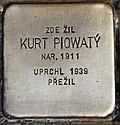
|
Kurt Piowatý | Štěpánská 317/3 |
Kurt Piowatý was born on July 9, 1911 in Brno. He was the son of Sigmund Piowaty and Elsa Piowatá. He studied law at Charles University in Prague and then worked as a lawyer in Prague. In 1939 he escaped to London on the last train. There he worked so that other family members could catch up. Here he met Helga Weinerovà, who was also from Brno, and married her. In 1939 the couple left London; they went to Panama with visas for Thailand. Here Kurt gave swimming lessons at the YMCA. When the United States issued US visas to foreign nationals in the Panama Canal Zone in 1940 , Kurt and Helga went to New York City. They had been given new American names and were now called Anthony and Helen Vernon. Friends helped Anthony get a job in a lending library. Probably because of the offer to manage the southeast area, both move to Atlanta. The couple had two children - Sheryl was born in 1946, and Andrew in 1948. In 1947, Anthony went to Europe in search of surviving family members and saw the extent of the Shoah . In the USA he was also successful as an inventor; so he developed the plastic covers for paperbacks and helped develop a machine that could make these covers.
In 1954 he founded a company, the American Library Line . In the same year he divorced Helen; In 1960 he married Evelyn Goldberg. He died on June 9, 1910, leaving two children and three grandchildren. |

|
Sigmund Piowatý | Štěpánská 317/3 |
Sigmund Piowatý was born on August 5, 1879 in Brno. He was a butcher. He was married to Elsa Piowatá (nee Rothschildová). The couple had a son - Karl Piowaty, born in 1911. On March 31, 1942, Sigmund Piowatá and his wife were deported to Theresienstadt on Transport Af (his number on the transport was 247). From there, together with his wife, he was transferred to Auschwitz on Transport Et (his number on the transport was 1093). Sigmund Piowaty and his wife did not survive the Shoah.
His son Karl escaped in 1939 and made a living in the USA (there as Anthony G. Vernon) and had a large family there (see Karl Piowaty). |
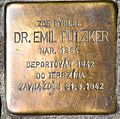
|
Emil Victor Putzker | Plotní 2 |
Dr. Emil Victor Putzker was born on April 2, 1861. He was a lawyer and married to Emma Putzerková. The couple had two children, Marie Irma (born 1896) and Fritz (born 1891). Together with his son Fritz, also a lawyer, he ran a law firm on Anastasius-Grün-Gasse in Brno. On March 29, 1942, he and his wife were deported from Brno to Theresienstadt on Transport Ae (his number on the transport was 136). Traveled two days later, on March 31, 1942, he died of a weak heart, according to a death certificate.
His wife did not survive the Shoah either; she died in Theresienstadt, her son Fritz was murdered in Riga in 1942. Daughter Marie Irma survived. |
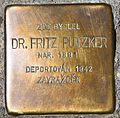
|
Fritz Putzker | Plotní 2 |
Fritz (Bedřich) Putzker was born on October 5, 1891. His parents were Dr. Emil Victor Putzker and Emma Putzkerová. He had a sister born in 1896 - Marie Irma. Fritz Putzker was a lawyer and had a law firm with his father on Anastasius-Grün-Gasse in Brno. On December 5, 1941, he was deported to Theresienstadt on Transport K (his number on the transport was 119); from there he was transferred to Riga on January 15, 1942 with Transport P (his number on the transport was 340). Fritz (Bedřich) Putzker did not survive the Shoah.
His parents were also deported to Theresienstadt in 1942 and did not survive. Only sister Marie Irma survived. |
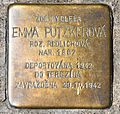
|
Emma Putzkerová (née Redlichová) |
Plotní 2 |
Emma Putzkerová was born on June 14, 1867. She was married to the lawyer Dr. Emil Viktor Putzker. The couple had two children - Marie Irma (born 1896) and Fritz (born 1891). On March 29, 1942, she and her husband were deported from Brno to Theresienstadt on Transport Ae (her number on the transport was 137). According to the death certificate, Emma Putzkerová died on October 29, 1942 of an intestinal catarrh.
Her husband did not survive Theresienstadt either; his death certificate was issued two days after arriving in the ghetto. Son Fritz was murdered in Riga. Daughter Marie Irma was also deported, but was able to survive. |

|
Julia Rauch (née Perlhefter) |
Lidická 1863/16 |
Doris Julia Rauch was born in 1920. Her parents were Alice Anna and Arthur Perlhefter. Her father died in 1936. In 1941 she was deported to Theresienstadt and from there transferred to Estonia in 1942. Doris Julia Rauch survived. |

|
Friedrich Redlich | Hybešova 42 |
Friedrich (Bedřich) Hynek Redlich was born on November 12, 1893. He was an industrialist and businessman. He was married to Marianne, née Löw. The marriage ended in divorce in 1928. In 1939 he fled to Paris with his sister Stefanie Redlich. But he returned to Brno. In 1942 his factory was Aryanized and on April 8, 1942 he was deported from Brno to Theresienstadt on the A1 transport (his number on the transport was 114). He fell in love in Theresienstadt, and when this woman had to go on a transport, he voluntarily escorted her and he was transferred to Auschwitz on October 23, 1944 with Transport Et (his number on the transport was 549). Since he was already gray-haired, he was immediately sent off the ramp into the gas chamber. Friedrich (Bedřich) Hynek Redlich was murdered by gassing in Auschwitz. |

|
Vojtěch Rosický | Drobného 315/54 |
Vojtěch Rosický was born on October 30, 1880 in Prague. He was a mineralogist and professor at Masaryk University ; there he founded the Institute for Mineralogy. He joined the resistance, was arrested for it in 1941 and deported to Mauthausen concentration camp in January 1942 . Vojtěch Rosický died there on February 9, 1942 due to poor nutrition, torture and the harsh winter. |
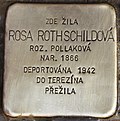
|
Rosa Rothschildová (nee Pollaková) |
Štěpánská 317/3 |
Rosa Rothschildová was born in 1866. She was deported to Theresienstadt in 1942. She could survive. |
| Viktor Roubíček | Františky Stránecké 545/7 | Viktor Roubíček was born on November 20, 1885 in Vlašim . He had a sister named Růžena, born in 1897. He attended a grammar school in Benešov and then studied law at the Charles University in Prague. From 1912 he was secretary of the Moravian Bar Association in Brno. Roubíček was already a member of the Sokol in his hometown and also became a member of the Sokol Brno I in 1931, but did not take an active part in club activities. On April 8, 1942 Viktor Roubíček was deported from Brno to Theresienstadt on Transport Ai (his transport number was 880). From here he was deported to Auschwitz on October 28, 1944 with Transport Ev (his number on the transport was 367). Viktor Roubíček was murdered here on the day of his arrival, October 28, 1944.
His name is commemorated on a memorial plaque for the victims of the occupation among the members of Sokol Brno I at Kounicova 20-22 / 01. His sister Růžena Roubíčková was also murdered in Auschwitz on October 12, 1944. |
|

|
František Skorkovský | Běhounská 105/1 |
František Skorkovský was born on October 1, 1909 in Trieste. He was the oldest of three children. He studied law at Masaryk University and received his doctorate in 1937. He was politically active and student leader. On November 11, 1939, protests against the German occupation broke out in Prague, during which the student Jan Opletal was killed. Skorkovský participated in the preparations for the burial of Opletal. On November 17, Skorkovský was arrested along with eight other student leaders and executed without trial. |

|
Eva Sobel | Orli 20 |
Eva Sobel was born on October 6, 1928 in Děčín . Her parents were Dr. Emil Sobel, a lawyer, and Nelly Sobel. The family came to Brno in 1938. Here Eva was the only student of the Jewish faith to attend the Ursuline School. In 1941 the school was closed. When the family was deported in 1942, they had meanwhile been living in Prague. From here, Eva and her parents were deported to Theresienstadt on July 27, 1942 on the AAu transport (her number on the transport was 399). From there, on August 25, again with her parents, she was transferred to the Maly Trostinez extermination camp on Transport Bc (her number on the transport was 760). Eva Sobel and her parents were murdered here in 1942. |
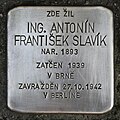
|
Antonín František Slavík | Tůmova 2086/15 |
Antonín František Slavík was born on January 20, 1893 in Prague. He was married to Marie, née Šerksová. The couple had two children - Vladimir (born 1921) and daughter Blažena (born 1923; she died in 1939). He studied at the Czech Technical University in Prague, interrupted his studies, served in the Austrian army during the First World War and fought on the Russian front. He later served in the Czechoslovak Army and became an officer in the telegraph force. In 1920 he became the commander of the military radio station in Bratislava. He finally graduated from the Electrical Engineering School in Brno, then went to the École supérieure d´électricité in Paris and studied music history and art history at Masaryk University from 1926 to 1931. He spoke seven languages - German, French, Polish, English, Italian, Esperanto and Russian.
In 1925 he began working for radio journal and eventually became director. He joined the resistance group Obrana národa . On December 14, 1939, he was arrested for this. First he was taken to the Špilberk fortress, then to the Kounicovy koleje, a building that was originally a student residence and since 1940 served as a Gestapo prison and execution site, then to Berlin. Here he was sentenced to death on June 9, 1942 and taken to Plötzensee prison. On October 27, 1942, the death sentence was carried out in Plötzensee. |

|
Hugo Sunshine | Malinovského náměstí 5 |
Dr. Hugo Sonnenschein was born on April 26, 1897 in Kyjov na Moravě. He was a psychiatrist and married to Trude, nee Mayer. The couple had two children - Otto (born 1927) and Pavel (born 1931). The family lived in Brno. On April 8, 1942, he was deported with his wife and two sons to Theresienstadt on Transport Ai (his number on the transport was 583). From there he was transferred to Auschwitz on October 23, 1944 with Transport Et (his number on the transport was 1391); again the entire family was transferred. Dr. Hugo Sonnenschein did not survive the Shoah ; neither did his wife Trude and his son Paul survive.
Son Otto Slunský was transferred from Auschwitz to Buchenwald and survived. |

|
Pavel sunshine | Malinovského náměstí 5 |
Pavel Sonnenschein was born on April 9, 1931 in Brno. He was the youngest child of Dr. Hugo Sonnenschein and Trude Sonnenscheinová. On April 8, 1942, he and his brother and parents were deported to Theresienstadt on Transport Ai (his number on the transport was 586). On October 23, 1944, he was transferred to the Auschwitz concentration camp with Transport Et (his number was 1393), again with his family. Pavel Sonnenschein did not survive the Shoah, neither did his parents.
His older brother Otto Slunský survived. |

|
Otto Slunský sunshine | Malinovského náměstí 5 |
Otto Slunský-Sonnenschein was born in 1937. He was the eldest son of Hugo Sonnenschein and Trude Sonnenscheinová. On April 8, 1942, he was deported to Theresienstadt with his brother and parents on Transport Ai. On October 23, 1944, he was transferred to the Auschwitz concentration camp with Transport Et. From there he was transferred to Buchenwald. Otto Slunský-Sonnenschein survived.
His parents and his brother Pavel did not survive the Shoah; they were probably murdered in Auschwitz. |

|
Trude Sonnenscheinová (nee Mayer) |
Malinovského náměstí 5 |
Trude (Gertruda) Sonnenscheinová was born on December 12, 1902. She was married to the psychiatrist Hugo Sonnenschein. The couple lived in Brno and had two sons - Otto (born 1927) and Pavel (born 1931). On April 8, 1942, Trude Sonnenscheinová was deported with children and her husband to Theresienstadt on Transport Ai (her number on the transport was 584). On October 23, 1944, she was transferred to the Auschwitz concentration camp with Transport Et (her number on the transport was 1392). Trude Sonnenscheinová did not survive the Shoah; Her husband and son Pavel were most likely also murdered in Auschwitz.
Son Otto Slunský-Sonnenschein survived. |

|
Karolina Tieberová (nee Friedelová) |
Tolstého 496/26 |
Karolina Tieberová b. Friedelová, also Karla, was born on September 1, 1873. Her last address before deportation was in Kroměříž . She was deported from Olomouc to the Theresienstadt concentration camp on June 30, 1942 with the Transport AAg . Her transport number was 877 of 901. In Theresienstadt she was murdered on August 8, 1942 by the Nazi regime. |
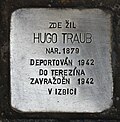
|
Hugo Traub | Čápkova 5 |
Hugo Traub was born in Čáslav on April 18, 1879 . He studied geography and history at Charles University in Prague. He worked as a teacher at grammar schools and from 1930 became an honorary lecturer at the Technical University of Brno. He wrote several specialist books and articles, especially on the political development of the 19th century.
On December 26, 1907, he married Ela, née Oplatková. On November 15, 1908, son Jiří Rostislav was born. From 1939 he was no longer allowed to teach and was dismissed for "racial reasons". On March 29, 1942, Hugo Traub and his wife were deported from Brno to Theresienstadt on Transport Ae (his prisoner number on this transport was 400); from there he and his wife were transferred to Izbica on Transport Aq (his prisoner number on this transport was 772). This transport brought 999 people to Izbica. Only two of them survived. Hugo Traub and his wife Ela did not survive the Shoah. His son Jiří Rostislav Traub became a lawyer and married the literary critic Vera Lišková, who was killed in a bomb attack in 1944; Jiří Rostislav survived. |

|
Ela (Elly) Traubová (nee Oplatková) |
Čápkova 5 |
Ela Traubová was born on November 17, 1887 in Mělník. On December 26, 1907, she married Hugo Traub , a historian. In 1908 their son Jiří Rostislav was born. On March 29, 1942, Ela Traubová and her husband were deported from Brno to Theresienstadt on Transport Ae (their number on this transport was 401); from there, she and her husband were transferred to Izbica with Transport Aq (their number on this transport was 773). This transport brought 999 people to Izbica; only two of them survived. Ela Traubová and her husband Hugo did not survive the Shoah. |

|
Jan Uher | Rudišova 161/6 |
Jan Uher was born on January 28, 1880 in Prostějov. He was married to Milada, nee Nedělníková. The couple had two sons - Boris (born 1923) and Jan (born 1928). He was a teacher at various schools and in 1919 became the personal librarian of the then President Tomáš Garrigue Masaryk for three years . In 1935 he was appointed associate professor for educational sciences at Masaryk University. He also became a professor at Comenius University (1937-1938) and director of studies at the State Pedagogical Academy in Bratislava.
Jan Uher joined the resistance group Obrana národa (Defender of the Nation). He was arrested for this on November 20, 1939, first in a prison on Mozart Street in Brno, then in the Špilberk fortress; from there he was sent to a prison in Breslau at the end of January 1940. In June 1941 he was transferred to a prison in Diez an der Lahn. On June 9, 1942, Jan Uher was sentenced to death in Berlin-Moabit; the death sentence was carried out on October 27, 1942 in Berlin-Plötzensee by beheading. |

|
Armin Weiner | Žampachova 1721/4 |
|

|
Anna Weinerová (née Perlhefter) |
Žampachova 1721/4 |
Anna Weinerová was born on August 8, 1893. She was married to Armin Weiner. The couple had three children: Hansi (born 1916), Hetty (born 1917) and Helga (born 1920). In 1939 Anna's entire family was able to flee, only she remained in Brno. On October 12, 1944, she was deported from Brno to Theresienstadt on Transport U (her number on the transport was 774); From here she was transferred to Auschwitz on October 12, 1944 with Transport Eq (her number on the transport was 1450). Anna Weinerová did not survive the Shoah .
Daughter Helga first fled to London, then came to Panama and finally to the USA. The siblings Hetty and Hansi also fled with their father in 1939 and survived. |

|
Helena Weiszová | Jakubské náměstí 4 |
Helena Weiszová was born on April 7, 1907. On March 23, 1942, she was deported from Brno to Theresienstadt on Transport Ad (her number on the transport was 618). On April 1, 1942, she was transferred with Transport Ag (her number on the transport was 761) to the Piaski ghetto . It is very likely that the transport to the Belzec extermination camp took place from this ghetto . Helena Weiszová did not survive the Shoah. |
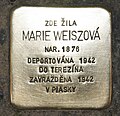
|
Marie Weiszová | Jakubské náměstí 4 |
Marie Weiszová was born in 1876. On March 23, 1942, she was deported from Brno to Theresienstadt on Transport Ad. On April 1, 1942, she was transferred to the Piaski ghetto on Transport Ag . It is very likely that the transport to the Belzec extermination camp took place from this ghetto . Marie Weiszová did not survive the Shoah. |
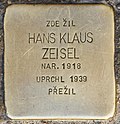
|
Hans Klaus Zeisel | Bratislavská 183/2 |
Hans Klaus Zeisel was born on January 31, 1918 in Brno. He was the only child of Louis Zeisel and his wife Lina. He studied medicine before fling and emigrating to the United States in 1939. He lived here as Charles Jan Zeman, had three children and died on November 14, 1975 in Kalamazoo . |

|
Louis Zeisel | Bratislavská 183/2 |
Louis Zeisel was born in Brno on August 23, 1880. He was married to Lina, nee Rothschild. The couple had a son - Hans Klaus (born 1918). On March 29, 1942, Louis Zeisel and his wife were deported to Theresienstadt on Transport Ae (his number on the transport was 22); from here he was transferred to Izbica with Transport Aq on April 27, 1942 (his number on the transport was 741), again together with his wife Lina. Louis Zeisel and his wife did not survive the Shoah. |

|
Lina Zeiselova (née Rothschild) |
Bratislavská 183/2 |
Lina Zeiselová was born on August 18, 1891 in Brno. She was married to Louis Zeisel. The couple had a son - Hans Klaus (born 1918). On March 29, 1942, she and her husband were deported to Theresienstadt on Transport Ae (her number on the transport was 23); from here she was transferred to Izbica with Transport Aq on April 27, 1942 (her number on the transport was 742), again together with her husband. Lina Zeiselová and her husband did not survive the Shoah. |
Laying data
The relocations in Brno took place on the following days:
- August 11, 2010: Plotní 2
- June 16, 2011: Bratislavská 183/2, Bratislavská 246/67, Bratislavská 250/69, Štěpánská 317/3, Táborská 923 / 193a, Žampachova 1721/4, Vlhká 176/19
- July 19, 2013: Burianovo náměstí 13/113, Čápkova 13/5, Františky Stránecké 545/7, Grohova 56a, Lesnická 1802/11, Mášova 744/24, Tolstého 496/26.
swell
- Holocaust.cz , Czech Holocaust database (German version)
- Stolpersteine.eu , Demnig's website
- Encyclopedia of the History of the City of Brno (Czech)
Web links
Individual evidence
- ↑ Zdeňka Kuchyňová: Praha má na chodnících své první pamětní Kameny holocaustu , report of the Czech radio station Radio Praha of October 19, 2008, online at: www.radio.cz / ...
- ↑ Report of the Stolpersteine.cz association , online at: Stolpersteine in the Czech Republic ( Memento from October 15, 2015 in the web archive archive.today )
- ↑ burda-auction.com
- ^ Entry for Alžběta Altensteinová at holocaust.cz
- ↑ Sexuologie - Journal for Sexualmedizin, Sexualtherapie und Sexualwissenschaft Volume 20/2013, p. 87
- ^ Auschwitz-Birkenau State Museum (ed.): Auschwitz death books, Volume 2/3: List of names AZ (reprinted 2012) . De Gruyter, Berlin / Boston 1995, ISBN 978-3-11-097409-6 , pp. 116 .
- ↑ Capri - Magazine for Gay History No. 49 2015
- ↑ db.yadvashem.org
- ↑ db.yadvashem.org
- ↑ Yad Vashem : Correspondence between Herta Laufer and Karl Laufer (brother and sister) in Eretz Israel and their family in Bruenn and Brünn, 1940-1942; announcement sent by the Red Cross Organization regarding the deaths of their parents and siblings, 1947; letter from Siegfried Laufer to Adolf Hitler, 1941; resident's certificate issued in Bruenn to Franz Frantisek Laufer, 06 November 1926 , accessed on 15 April 2016
- ↑ Avotaynu: The International Review of Jewish Genealogy, Volume 12
- ↑ zmizeli-sousede.cz ( Memento of the original from March 4, 2016 in the Internet Archive ) Info: The archive link was inserted automatically and has not yet been checked. Please check the original and archive link according to the instructions and then remove this notice.
- ↑ zmizeli-sousede.cz ( Memento of the original from March 4, 2016 in the Internet Archive ) Info: The archive link was inserted automatically and has not yet been checked. Please check the original and archive link according to the instructions and then remove this notice.
- ↑ zmizeli-sousede.cz ( Memento of the original from March 4, 2016 in the Internet Archive ) Info: The archive link was inserted automatically and has not yet been checked. Please check the original and archive link according to the instructions and then remove this notice.
- ↑ zmizeli-sousede.cz ( Memento of the original from March 4, 2016 in the Internet Archive ) Info: The archive link was inserted automatically and has not yet been checked. Please check the original and archive link according to the instructions and then remove this notice.
- ↑ legacy.com
- ↑ JUDr. Viktor Roubíček in: In: Encyclopedia of the History of the City of Brno (Czech) , accessed on August 18, 2017
- ↑ Růžena Roubíčková In: Encyclopedia of the History of the City of Brno (Czech) , accessed on August 18, 2017
- ↑ Ursulinennachrichten 1/2013 p. 25
- ↑ holocaust.cz: KARLA TIEBEROVÁ , accessed on May 10, 2017
- ↑ holocaust.cz
- ↑ Information about the publishing encyclopedia of the history of the city of Brno (Czech)
- ↑ Information about the laying with photos that show Gunter Demnig laying
- ↑ Brna Encyclopedia: ZASAZENÍ NOVÝCH PAMĚTNÍCH KOSTEK, TZV. "STOLPERSTEINE", ZVANÝCH TÉŽ "KAMENY ZMIZELÝCH" , accessed on May 10, 2017
